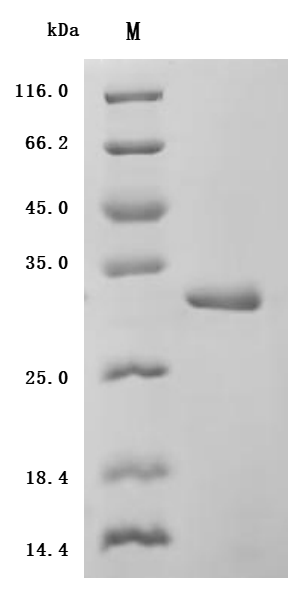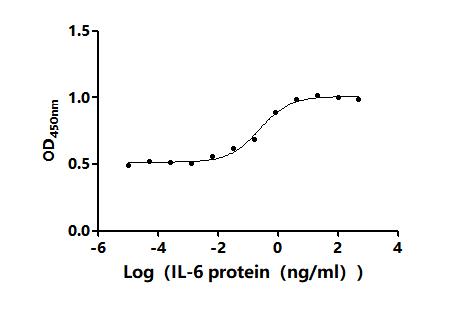The recombinant human IL6 protein is generated in E. coli. Its expression region is the gene segment coding for the 30-212aa of the human IL6 protein. It is N-terminally tagged with a 6xHis-tag for easy purification and detection. This recombinant IL6 protein is highly pure, with a purity greater than 95% as confirmed by SDS-PAGE, and contains less than 1.0 EU/µg endotoxin, as determined by the LAL method. This IL6 protein is biologically active as demonstrated by its ability to stimulate the proliferation of human TF-1 cells in a dose-dependent manner, with an ED50 value of 0.1518 - 0.3987 ng/mL.
IL6 is a multifunctional cytokine involved in immune regulation, inflammation, and metabolic processes. It is produced by various cells, including lymphocytes, macrophages, and fibroblasts. IL6 acts as a pro-inflammatory cytokine, promoting the differentiation of B cells and the activation of T cells, which are crucial for adaptive immunity [1]. IL6 also stimulates the production of acute-phase proteins in the liver, such as C-reactive protein (CRP), which is a marker of inflammation [2]. This cytokine is particularly important during infections and tissue injuries, where it helps to orchestrate the inflammatory response [3]. Elevated levels of IL6 have been associated with various inflammatory conditions, including rheumatoid arthritis and inflammatory bowel diseases, which contribute to the pathogenesis of these diseases by promoting inflammation and tissue damage [4][5].
IL6 is also recognized as a myokine, which means it is produced by muscle cells during exercise. This production of IL6 is associated with increased exercise capacity and metabolic adaptations, such as enhanced lipid metabolism and insulin sensitivity [6][7]. Furthermore, IL6 has been implicated in the regulation of energy homeostasis and the pathophysiology of obesity, where it can influence insulin resistance and metabolic syndrome [8]. IL6 also plays a critical role in cardiovascular health. It has been shown to mediate myocardial fibrosis and hypertrophy, contributing to diastolic dysfunction in the heart [9].
In the context of reproductive health, IL6 is essential for spermatogenesis and has been linked to male infertility. It regulates the function of Sertoli cells, which are crucial for sperm development, and its dysregulation can lead to impaired fertility [10]. IL6 can promote tumor growth and metastasis by enhancing the survival of cancer cells and facilitating angiogenesis [11]. Elevated IL6 levels in the tumor microenvironment are often associated with poor prognosis in various cancers, including breast cancer [11].
References:
[1] N. Yamamoto, H. Tokuda, G. Kuroyanagi, S. Kainuma, R. Ohguchi, K. Fujita, et al. Amplification by (-)-epigallocatechin gallate and chlorogenic acid of tnf-α-stimulated interleukin-6 synthesis in osteoblasts, International Journal of Molecular Medicine, vol. 36, no. 6, p. 1707-1712, 2015. https://doi.org/10.3892/ijmm.2015.2381
[2] E. Graham, E. Bastarache, E. Milad, N. Turiano, K. Cotter, & D. Mroczek. Physical activity mediates the association between personality and biomarkers of inflammation, Sage Open Medicine, vol. 6, 2018. https://doi.org/10.1177/2050312118774990
[3] M. Al-Jebouri and B. Al-Mahmood. Estimation of cytokines involved in acute-phase wound infection with reference to residence time of patients in hospitals, Modern Research in Inflammation, vol. 08, no. 01, p. 1-10, 2019. https://doi.org/10.4236/mri.2019.81001
[4] S. Nikolaus, G. Waetzig, S. Butzin, M. Ziolkiewicz, N. Al-Massad, F. Thieme, et al. Evaluation of interleukin-6 and its soluble receptor components sil-6r and sgp130 as markers of inflammation in inflammatory bowel diseases, International Journal of Colorectal Disease, vol. 33, no. 7, p. 927-936, 2018. https://doi.org/10.1007/s00384-018-3069-8
[5] X. Luo, J. Chen, J. Ruan, Y. Chen, X. Mo, J. Xie, et al. Krüppel-like factor 4 is a regulator of proinflammatory signaling in fibroblast-like synoviocytes through increased il-6 expression, Mediators of Inflammation, vol. 2016, p. 1-13, 2016. https://doi.org/10.1155/2016/1062586
[6] S. Chowdhury, L. Schulz, B. Palmisano, P. Singh, J. Berger, V. Yadav, et al. Muscle-derived interleukin 6 increases exercise capacity by signaling in osteoblasts, Journal of Clinical Investigation, vol. 130, no. 6, p. 2888-2902, 2020. https://doi.org/10.1172/jci133572
[7] E. Obeagu, G. Obeagu, M. Cantero, C. Okafor, Y. Bot, G. Eze, et al. Evaluation of plasma levels of interleukin 6 and iron of volleyball players based on heights and weight of a nigerian university students, Asian Journal of Medicine and Health, p. 147-152, 2022. https://doi.org/10.9734/ajmah/2022/v20i1030515
[8] L. El-Kadre and A. Tinoco. Interleukin-6 and obesity, Current Opinion in Clinical Nutrition & Metabolic Care, p. 1, 2013. https://doi.org/10.1097/mco.0b013e32836410e6
[9] G. Meléndez, J. McLarty, S. Levick, Y. Du, J. Janicki, & G. Brower. Interleukin 6 mediates myocardial fibrosis, concentric hypertrophy, and diastolic dysfunction in rats, Hypertension, vol. 56, no. 2, p. 225-231, 2010. https://doi.org/10.1161/hypertensionaha.109.148635
[10] O. Hachim, A. Al-Salih, & S. AL-Alwach. Study of interleukin-6 (il-6) profile in the seminal fluid of oligozoospermia men, Iraqi Journal of Embryos and Infertility Researches, vol. 5, no. 1, 2015. https://doi.org/10.28969/ijeir.v5.r6
[11] H. Hassan, B. Greve, M. Pavão, L. Kiesel, S. Ibrahim, & M. Götte, Syndecan‐1 modulates β‐integrin‐dependent and interleukin‐6‐dependent functions in breast cancer cell adhesion, migration, and resistance to irradiation, Febs Journal, vol. 280, no. 10, p. 2216-2227, 2013. https://doi.org/10.1111/febs.12111








